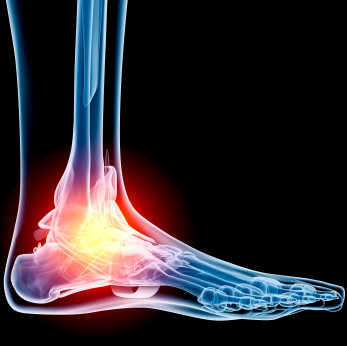This article discusses an innovative form of treatment for ankle injuries, known as keyhole surgery or arthroscopy. This will be of interest to anyone who is looking for alternative treatment options for their ankle injuries.
Contents
- What is ankle arthroscopy?
- What does keyhole surgery to the ankle involve?
- What are the risks of keyhole surgery to the ankle?
- What happens after keyhole surgery to the ankle?
What is ankle arthroscopy?
The tissue that forms the lining of the ankle joint (articular cartilage) can be damaged by impact from falls or by twisting injuries to the foot. This damaged lining can float around in the joint as a ‘loose body’, or be a flap still attached to the rest of the cartilage. In more severe cases there may be a piece of bone also damaged beneath the surface (called an ‘osteochondral defect’ or OCD). These conditions (amongst others) can be treated by keyhole surgery (arthroscopy) to the joint using a small (3.5mm) tube with a miniature video camera as well as small operating instruments in the joint.
What does keyhole surgery to the ankle involve?

The surgery is performed with a tourniquet around the leg to stop blood flow obscuring vision in the joint, which makes the operation unsuitable for local anaesthesia. It is usually done with the patient asleep (general anaesthetic) but it may be done with a spinal injection.
The surgeon makes two small (5mm) cuts on the front of the ankle and inserts the arthroscope through one, and the instruments through the other. The holes may need enlarging into an open wound if there are loose bodies to be removed (arthrotomy) or if some bone needs shaving away at the front of the joint. Sometimes a third hole at the back of the joint is necessary.
If the lining of the joint is shown to be damaged (usually seen on MRI scanning before surgery) then the surgeon may discuss trying to create scar tissue (fibrocartilage) to fill the gap. If the area is easily accessible from the front of the joint, it is relatively straightforward. If however it is in the centre of the joint, it may need actually cutting through the bone on the inner side of the ankle (osteotomy) to get to the involved joint surface, then fixing back the detached bone with small metal screws.
What are the risks of keyhole surgery to the ankle?
Ankle arthroscopy is a very safe operation, but as with all operations there are risks. About two cases in 100 will develop an infection, which can usually be treated with antibiotics, and about three in 100 will develop blood clots in the calf (Deep Vein Thrombosis/DVT) that will need treatment. In less than one in 100 cases a blood clot will go off to the lung (pulmonary embolism), which can be dangerous. There are other risks such as numb patches on the ankle or the side of the foot. The exact level of risk is dependent on a lot of factors; your surgeon should discuss these risks with you before surgery. The anaesthetist will also see you to discuss the anaesthetic and what it involves.
What happens after keyhole surgery to the ankle?
A bulky dressing will be applied to try to reduce the bruising and swelling after the operation that will be changed for simple dressings and an elasticated support bandage two or three days after surgery. The holes often (but not always) have stitches, which are usually removed by the GP after ten days or so. Until they are, the wounds need a waterproof dressing to shower; complete immersion such as swimming is not recommended. If an osteotomy has been performed, the ankle will be in plaster for six weeks (the plaster will need changing at two weeks to remove the stitches).
Sometimes, particularly if surgery to stimulate a fibrocartilage layer has been performed, crutches will be needed. Usually, however, most patients can weight-bear immediately after surgery. The ankle is sore for a few days and you will normally be sent home with painkillers. After three or four days though it is merely achy, and most people can manage with paracetamol.
The physiotherapist will give you exercises to do at home, and the nursing staff and surgeon will give you specific instructions and arrange a follow-up appointment (usually about three weeks after surgery). It is usually a day case surgery, but you will not be fit to drive yourself, and we recommend that someone should stay with you at home on the night of surgery in case there are any complications.
Most people are back in a gym at six weeks, starting to run at eight weeks, and a few can play sports such as football after twelve weeks, depending on what was done in the joint.





